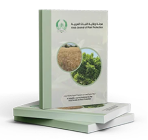M. Ali*, N. Allouf and M. Ahmad
Department of Plant Protection, Faculty of Agriculture, Tishreen University, Syria.
*Email address of the corresponding author: [email protected]
Received: 12/4/2024; Accepted: 3/5/2024
eSSN 2412-5407
pISSN 0255-982X
مجلة وقاية النبات العربية
Arab Journal of Plant Protection
A Regional Scientific Journal Published Four Times a Year by the Arab Society for Plant Protection
Evaluation of the Efficacy of Three Native Isolates of Entomopathogenic Nematodes Against Tuta absoluta Under Laboratory Conditions and in Pot Experiments
Abstract
The efficacy of three native isolates of entomopathogenic nematodes: Heterorhabditis bacteriophora (H), H. indica (Fn) and Steinernema affine (313) was assessed against 3rd and 4th instar larvae (both outside and inside leaf tunnels) and pupae of Tuta absoluta, a destructive pest in Syria, at 25°C. In the laboratory, the isolates were tested on larvae outside leaf tunnels, at different doses 1, 5, 10, 15, 25 and 50 infective juveniles IJs/larva. The results obtained showed the susceptibility of larval instars to nematode infection, with variation according to the isolate, the concentration, and the larval instar stage inoculated. The isolate H exhibited the highest mortality rates across all treatments, followed by the isolate Fn, while the isolate 313 had the least virulence. The 50% lethal doses (LD50) for the three isolates against the 3rd and 4th larval instars, were 9.62 and 7.57 IJs/larva for isolate H; 12.33 and 8.24 for isolate Fn; 30.36 and 24.20 for isolate 313, respectively. The two most efficient isolates from the previous experiment, H and Fn, demonstrated the capability to access and kill larvae within the leaf tunnels with no significant difference between them. The H isolate exhibited mortality rates of 37.12 and 45.66%, whereas the Fn isolate produced mortality rates of 34.33 and 41.12% for 3rd and 4th instar larvae, respectively. Nevertheless, their efficacy on pupae was comparatively lower, with the H isolate displaying the highest mortality rate of 12.33%. In pot experiments, two concentrations (500 and 1000 IJs/ml) of H and Fn isolates were applied, with no significant differences observed between the two isolates. Although their efficacy was limited on pupae, the virulence on larvae instars was evident and increased with heightened concentrations and instar progression, achieving mortality rates for the 4th instar of 94.27 and 83.87% outside and inside leaf tunnels of the H isolate, and 91.66 and 80.10% for the Fn isolate, respectively. These findings suggest that entomopathogenic nematodes adapted to moderately warm temperatures are considered promising effective biological control agents against Tuta absoluta. Further in-depth research and practical applications within greenhouses are needed.
Keywords:
Biological control, entomopathogenic nematodes, Heterorhabditis, Steinernema, Tuta absoluta, LD50.


 https://doi.org/10.22268/AJPP-001325
https://doi.org/10.22268/AJPP-001325